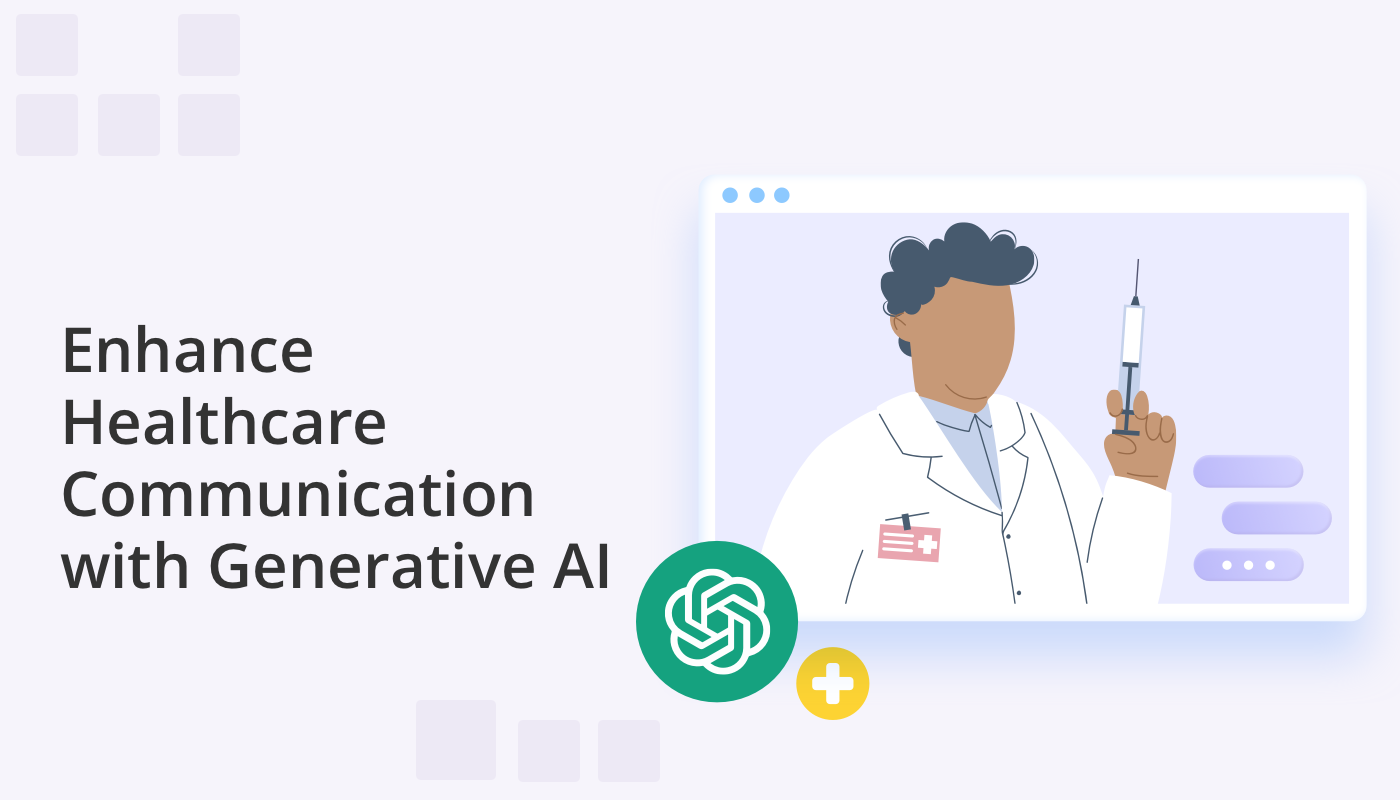
Updated since its first publication in 2023.
Summary: The rise of generative AI and its integration into healthcare has the potential to transform healthcare communication, increasing patient engagement, improving accessibility, and providing personalized healthcare experiences. The following essay will discuss how generative AI can enhance real-time communication for healthcare professionals and patients and the potential benefits and challenges associated with its implementation in a healthcare setting.
Table of Contents
Introduction
Generative AI is revolutionizing the healthcare industry by transforming how patients and providers communicate. Through advanced natural language processing and machine learning algorithms, generative AI enables the creation of sophisticated chatbots and virtual assistants that can understand and respond to patient inquiries with remarkable accuracy. Furthermore, because of its ability to understand and mimic patterns, styles, and structures found in the data it has been trained on, generative AI models can produce text that is remarkably similar to human-written content.
These AI-driven tools not only enhance the efficiency of healthcare communication but also ensure personalized patient experiences by providing real-time, contextually relevant information. Its potential has many healthcare professionals excited. In an AMA Survey, 65% of over 1000 surveyed physicians stated they saw an advantage to AI. In particular, they believed it held the promise of reducing administrative burdens on healthcare professionals, including documentation (54%), and prior authorization (48%).
This article explores the myriad ways generative AI is enhancing healthcare communication, paving the way for a more connected and responsive healthcare ecosystem.
Applications of Generative AI in Healthcare Communication
Generative AI has found a wide range of applications in healthcare communication, each contributing to more efficient, personalized, and accessible interactions between patients and providers. Here are some key applications:
Healthcare ChatBots:
Chatbots with generative AI capabilities are beginning to appear on healthcare websites and apps, providing patients with round-the-clock access to support. These AI-powered systems can book appointments, provide information on symptoms or prescriptions, and answer queries, lightening the workload for medical professionals and guaranteeing prompt, reliable, and accurate responses.
In particular, these generative AI chatbots are useful for managing patient onboarding and triage. In order to assess the urgency and seriousness of a patient’s condition, they can serve as the initial point of contact for triage, asking patient’s questions about their symptoms and medical background. Several healthcare organization’s have integrated tools like SmartChat Assistant by QuickBlox into their platforms, enabling patients to interact directly with a HIPAA-compliant AI chatbot. SmartChat can streamline patient intake with AI because it has been integrated with automated intake forms, allowing it to collect relevant data and reassign the patient to a doctor or administrator when needed. For example, when SmartChat is unable to provide the necessary level of care, it can hand over patient queries to a human agent.
Chatbots are also great at handling standard patient FAQs. Cleveland Clinic is exploring the utility of ChatGPT and other AI technologies to help with patient inquiries, especially in areas like preventive cardiology. Their research showed that 84% of common queries patients might have about cardiology online or via a patient portal could be successfully answered using ChatGPT.
Clinical Note Taking:
Generative AI is transforming clinical note-taking by enabling healthcare professionals to dictate patient interactions, diagnoses, and treatment plans. This ensures that patient records are accurate and up-to-date while also saving time and lowering the possibility of human error in documentation. A number of health systems have already incorporated such technologies to boost productivity and reduce the amount of paperwork that physicians must complete.
Tools like AWS’s HealthScribe by AWS and Dragon Medical One by Nuance automate the creation of clinical notes from doctor-patient conversations with voice recognition and generative AI. During or after patient contacts, healthcare workers can use this technology to dictate notes, which the AI will later turn into organized clinical records.
AI tools like Q-Consultation can also transcribe audio and video calls and then create concise summaries and action points from those transcriptions. It can capture key details, making medical recordkeeping more efficient.
Virtual Assistants for Telemedicine:
Telemedicine platforms have begun to incorporate generative AI to enable remote consultations between medical experts and patients. By assisting with appointment scheduling, gathering medical data, and call transcription and note-taking, AI-powered assistants can improve the efficiency and accessibility of telehealth services.
For example, Oracle’s Clinical Digital Assistant automates note-taking and suggests context-aware actions in patient-doctor consultations. Through AI-powered voice recognition, the Oracle Assistant captures and analyzes key details from doctor-patient discussions and automatically converts this data into an organized clinical note in the Oracle Health EHR system. Physicians can quickly review and approve the AI-generated documents, greatly speeding up the documentation process.
“By bringing comprehensive generative AI and voice-first capabilities to our EHR platforms,” Oracle’s product manager noted, “we are not only helping providers reduce mundane work that leads to burnout, but we are also empowering them to create better interactions with patients that establish trust, build loyalty, and deliver better outcomes.”
Language Translation:
Generative AI can be leveraged to bridge language gaps between healthcare providers and patients who speak different languages. It can act as a real-time translator, facilitating communication between patients and healthcare providers who speak different languages, thereby improving patient-provider interactions.
AI technologies can also translate medical jargon into more understandable phrases and simplify it. Generative AI, for instance, would translate “benign prostatic hyperplasia” into more understandable terms for patients, like “enlarged prostate.” This feature is essential for minimizing miscommunication and enabling patients to get the information they need.
Training and Medical Education:
By replicating patient interactions, generative AI is also transforming medical education. Medical students can practice diagnosing and communicating with virtual patients in realistic training environments created by AI-driven models. Students can encounter a variety of clinical settings through these AI-generated scenarios, which aid in the development of their critical thinking and decision-making abilities in a safe, regulated setting.
Remote Patient Monitoring:
By evaluating data from wearables and sensors, generative AI is transforming remote patient monitoring. Platforms like HealthSnap allows for the real-time monitoring of vital signs and other health metrics, as well as the automatic provision of warnings in the event of the discovery of anomalous patterns or potential health issues. This makes it possible for medical professionals to act quickly, which may avoid complications and lessen the need for readmissions to the hospital.
On-going Patient Care:
Generative AI can help healthcare providers maintain ongoing communication with patients. These AI-powered solutions have the ability to deliver tailored reminders for follow-up appointments and help patients manage their medications by providing reminders, dosage instructions, and information about potential side effects and interactions.
Additionally, these technologies provide health advice and motivation. By analyzing an individual’s medical history and preferences, it can generate content tailored to their specific needs, promoting health literacy. By offering educational content and real-time feedback, generative AI tools can encourage better adherence to treatment plans.
Benefits of Generative AI in Healthcare Communication
Given the diverse and numerous ways generative AI has been applied to healthcare use cases, it offers a myriad of benefits to patients and healthcare providers alike.
Accessibility
Generative AI makes healthcare information accessible to all, regardless of linguistic background or disability. By providing multilingual support, breaking down medical jargon, summarizing content, and offering speech-to-text translation and vice versa, generative AI promotes inclusivity and expanded healthcare reach.
For example, more than half of participants in Deloitte’s 2023 Health Care Consumer Survey think generative AI may enhance patient access to healthcare, particularly by giving them information that empowers them to make wise decisions. For those without insurance, who are more likely to use these resources to help them obtain healthcare, this is especially advantageous.
Collaboration
Generative AI can facilitate communication among different healthcare professionals and disciplines. It can help break down complex medical information and streamline data sharing, making it comprehensible and accessible to professionals from various fields, thereby facilitating communication essential for delivering coordinated, patient-centered care.
Empowerment
With generative AI, patients can actively engage in their healthcare journey. They can schedule appointments, access clinical information, and receive reminders through simple voice commands. Generative AI can offer patients the necessary guidance and assistance for effectively managing their health remotely from a distance. This autonomy not only empowers patients but also promotes better adherence to treatment plans.
Efficiency
The integration of generative AI into EHR systems facilities workflow efficiency, internal communication, and knowledge sharing. The automation of time-consuming administrative tasks , such as clinical note-taking and documentation, further streamlines work processes, reducing the administrative burden and allowing healthcare professionals to redirect their focus toward patient care.
Challenges and Future Considerations
While generative AI holds immense promise in revolutionizing healthcare communication, there are several challenges and considerations that need to be addressed. These include:
1. Data Privacy and Security
Making sure data is secure and private is one of the main obstacles to using generative AI in healthcare. For AI models to produce precise and individualized suggestions, enormous volumes of private patient data are required. However, there are worries over patient confidentiality and possible data exploitation because this data is frequently vulnerable to breaches and illegal access. It is crucial to make sure that laws like the General Data Protection Regulation (GDPR) in Europe and the Health Insurance Portability and Accountability Act (HIPAA) in the United States are followed. To secure patient information, healthcare institutions need to put strong encryption, access controls, and data anonymization strategies in place.
2. Bias and Fairness in AI Data Sets
Generative AI models are trained on large datasets that may contain inherent biases, reflecting societal and historical prejudices. In healthcare, biased AI can lead to unequal treatment recommendations, misdiagnosis, or even worsen existing health disparities among different patient groups. For example, an AI model that was primarily trained on data from a particular demography would not function effectively for underrepresented groups. In order to address these biases, training data must be carefully chosen and curated, models must be continuously evaluated, and fairness and equity principles must be incorporated into AI development.
3. Integration into Clinical Workflows
Another major problem is integrating generative AI into current clinical practices. The administrative responsibilities that healthcare workers already face are heavy, and learning new technologies can make their job even more difficult. AI needs to be user-friendly, work easily with EHR systems, and not interfere with clinical procedures in order to be integrated successfully. Additionally, in order to safely and efficiently integrate AI recommendations into their decision-making processes, providers must receive training in this area.
4. Regulatory and Ethical Considerations
Comprehensive guidelines and regulations need to be established to ensure responsible integration of generative AI in healthcare settings. Regulators are concerned with the accuracy, reliability, and ethical implications of AI-generated outputs. For example, if AI makes a mistaken diagnosis or recommendation, healthcare professionals may face serious legal repercussions.
Additionally, there are ethical concerns around the “black box” nature of AI models, which can make it difficult to explain or justify their decisions. This lack of transparency can erode trust among healthcare professionals and patients. In order to guarantee that their solutions are transparent and compliant, AI developers must collaborate closely with regulatory organizations.
Wrapping up
Generative AI has undeniably become a linchpin in revolutionizing healthcare communication. It’s breaking down linguistic barriers, empowering patients to take an active role in their health, and enhancing the efficiency and quality of healthcare services.
For those seeking a healthcare communication solution integrated with generative AI, QuickBlox offers a range of solutions, including a HIPAA-compliant SmartChat Assistant and AI-enhanced white label video consultation app. To find out more, contact us today.
Talk to a sales expert
Learn more about our products and get your questions answered.
Contact sales









This is a great insight into how generative AI can transform healthcare communication. Clear, efficient, and personalized interactions are exactly what providers and patients need. Excited to see how innovations like this will continue improving care quality and workflow efficiency.